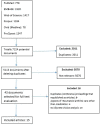A Systematic Review of Discrete Choice Experiment Studies in Rheumatoid Arthritis Biological Medicines
- PMID: 34447905
- PMCID: PMC8369269
- DOI: 10.31138/mjr.32.2.104
A Systematic Review of Discrete Choice Experiment Studies in Rheumatoid Arthritis Biological Medicines
Abstract
Objective: Rheumatoid arthritis is a chronic disease with various clinical characteristics. The introduction of biological drugs has enhanced the efficacy and increased diversity of treatment options. Considering the patients' preferences in decision-making about treatment can improve their adherence. A discrete choice experiment is a type of conjoint method that can elicit preferences in more realistic scenarios. This article reviewed discrete choice experiment (DCE) studies to extract which attributes and levels were included in surveys. In addition, we focused on the process of designing surveys and the method that they used. Method: PubMed, EMBASE, Web of Science, Scopus, Ovid (Medline) and ProQuest were systematically searched in order to find studies that evaluated rheumatoid arthritis patients' preferences about biological medicines. Studies published in peer-reviewed journals between 1/1/1990 and 12/31/2019 were included. The included studies were analyzed using a narrative synthesis method and descriptive statistics.
Results: A total of 7124 studies were initially found. After deleting irrelevant and duplicate studies, 15 studies were included. The most common attributes that were used in surveys were efficacy, adverse effect, route of administration, frequency of administration, and cost. Most studies used a literature review for developing attributes and levels. The median number of included attributes and levels were seven and three, respectively. Eight studies explained their experimental design while seven studies did not. Conditional logit and mixed logit were the most common methods for modeling reciprocally.
Conclusion: Several aspects of DCE studies investigating biological drugs in RA were assessed. Explaining the sample size, experimental design, and qualitative work for developing attributes can improve this type of study.
Keywords: Rheumatoid arthritis; biological products; conjoint method; discrete choice experiment; patient preference.
© 2021 The Mediterranean Journal of Rheumatology (MJR).
Figures
References
-
- Sangha O.Epidemiology of rheumatic diseases. Rheumatology 2000;39(suppl_2):3–12. - PubMed
-
- Husni ME, Betts KA, Griffith J, Song Y, Ganguli A.Benefit-risk trade-offs for treatment decisions in moderate-to-severe rheumatoid arthritis: focus on the patient perspective. Rheumatol Int 2017;37(9):1423–1434. - PubMed
-
- Suarez-Almazor ME, Conner-Spady B, Kendall CJ, Russell AS, Skeith K.Lack of congruence in the ratings of patients’ health status by patients and their physicians. Med Decis Making 2001;21(2):113–21. - PubMed
-
- Kassirer JP.Incorporating patients’ preferences into medical decisions. N Engl J Med 1994June30;330(26):1895–6. - PubMed
Publication types
LinkOut - more resources
Full Text Sources





